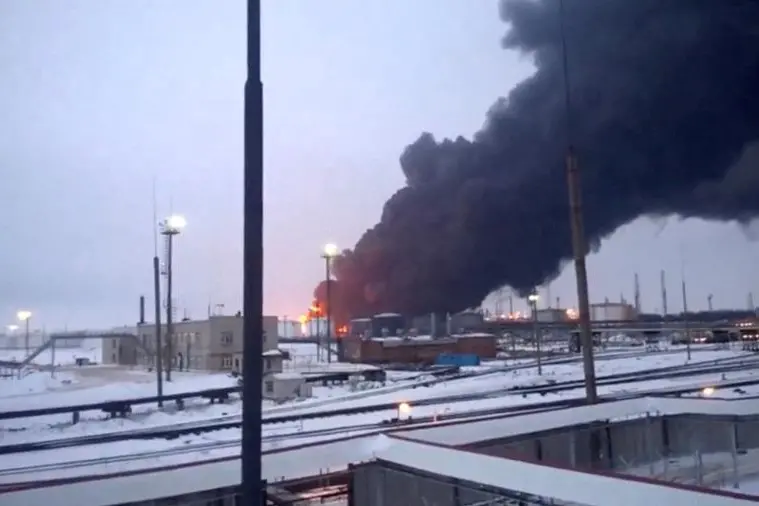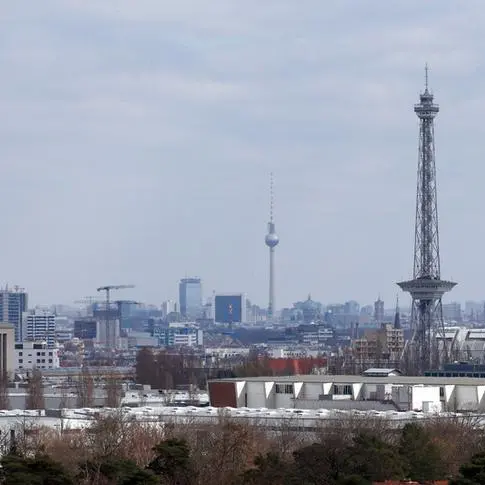PHOTO
Rosneft's Kuibyshev oil refinery in Russia's city of Samara halted refining unit CDU-5, knocking out half of its capacity following a drone attack over the weekend, two industry sources told Reuters on Monday.
Russian oil refining capacity that was shut down in the first quarter due to Ukrainian drone attacks on at least seven refineries amounts to about 4.6 million tons (370,500 barrels per day), or some 7% of the total, Reuters calculations show, on top of maintenance related to other reasons.
What was targeted and what do Russian oil refineries produce?
KUIBYSHEV
Regional Governor Dmitry Azarov has said a fire broke out at the refinery after a Ukrainian drone attacked it on Saturday morning, according to Interfax news agency. The blaze engulfed the primary oil refining unit, he said.
According to industry sources, the attack led to halting of CDU-5, one of two primary refining units, knocking out half of its capacity.
CDU-5 has production power of 9,500 metric tons per day (70,000 barrels per day), around half its capacity.
Another primary oil refining unit, CDU-4, has production capacity of 10,500 tons per day. It was not immediately clear if the unit was working normally.
Last year, the Kuibyshev plant was Russia's 29th biggest oil refinery by output, accounting for 1.34% of total oil refining throughput, having processed 3.687 million tons of crude oil.
It produced 624,000 tons of gasoline (1.42% of Russia's total), 1.187 million tons of diesel (1.35%), and 1.040 million tons of fuel oil (2.56%).
RYAZAN
Russia's Ryazan oil refinery, controlled by Rosneft, was set ablaze after a drone attack on March 13.
The plant, with installed capacity of around 350,000 barrels per day, refines about 12.7 million metric tons of Russian crude a year (around 317,000 barrels per day), or 5.8% of total refined crude, according to industry sources.
It has shut down two damaged primary oil refining units after a fire, two sources familiar with the situation told Reuters. Rosneft did not reply to a request for comment.
Ryazan has stopped its main crude distillation unit AVT-6 with a capacity of 170,00 barrels of crude per day (47.5% of the plant's total crude intake capacity) and a smaller CDU AVT-4 capable of refining about 84,000 barrels of crude per day (23.4% of the plant's total intake capacity), the sources said.
As a result of the attack, Ryazan's idle crude refining capacity may reach 70% of the plant's total during the maintenance period, according to sources and Reuters calculations.
NOVOSHAKHTINSK
The Novoshakhtinsk oil refinery in Russia's southern Rostov region suspended operations on March 13 after downed drones fell on the site, but resumed later in the day. However it is yet unknown if the normal processing level was maintained.
Oil processing at the refinery in 2023 averaged around 96,000 barrels per day, according to industry sources. The plant produces no motor fuels for the domestic market. Its production is limited to straight-run fractions for exports.
NORSI
A fire broke out at NORSI, Russia's fourth largest refinery, after a Ukrainian drone attack, Russian officials said on March 12. It is located near the city of Nizhny Novgorod, 430 kms (270 miles) east of Moscow.
Owned by Lukoil, its formal name is Lukoil Nizhegorodnefteorgsintez.
NORSI refines about 15.8 million tons of Russian crude a year (317,000 barrels per day), or 5.8% of total refined crude, according to industry sources.
Its main crude distillation unit (AVT-6) was damaged, which means that at least half of the refinery's production is halted, industry sources told Reuters.
In 2023 NORSI produced about 4.9 million tons of gasoline - 11% of Russia's total - 6.4% of diesel fuel, 5.6% of fuel oil and 7.4% of the country's aviation fuel, industry sources said.
Lukoil said in January that it had halted a unit at the refinery due to an incident.
Industry sources said before the March 12 drone attack, one of two catalytic crackers remained out of action at the plant.
KIRISHI
The governor of the Leningrad region, Alexander Drozdenko, said on March 12 a Ukrainian drone had been destroyed on the outskirts of Kirishi, which is home to Surgutneftegaz's Kirishinefteorgsintez (KINEF) refinery.
The Kirishi refinery is one of the top two refineries in Russia. It refines about 17.7 million tons per year (355,000 barrels per day) of Russian crude, or 6.4% of the total, according to industry sources.
It produces about 2.3 million tons of gasoline - 5.3% of Russia's total - 7.6% of diesel fuel, 16.3% of fuel oil and 3.4% of the country's aviation fuel, according to industry sources.
SYZRAN
Russia's Syzran oil refinery, controlled by Rosneft, burned for hours on March 16 before it was brought under control after a strike by Ukrainian drones.
One of its two CDU units was damaged due to the fire, according to Reuters sources, meaning the refinery may need to suspend operations.
The Syzran refinery has the capacity to process 8.5 million metric tons of crude oil a year, or 170,000 barrels per day (bpd), but its actual runs were lower.
In 2023 the refinery processed just 5 million metric tons of crude oil, about 100,000 bpd.
The Syzran refinery produced about 1 million tons of gasoline in 2023 - 2.2% of Russia's total and 1.78 million metric tons of diesel fuel, about 2% of the state's total, according to industry sources and Reuters calculations.
A Ukrainian source has told Reuters that Kyiv's SBU intelligence agency had struck three Samara region Rosneft refineries: Syzran, Novokuibyshevsky, and Kuibyshevsky.
The attack on Novokuibyshevsky refinery was thwarted, according to the local governor. Russian media have not reported a strike on the Kuibyshevsky refinery, which is located in the city of Samara.
SLAVYANSK
On March 18, the Slavyansk refinery in Krasnodar region caught fire after a drone attack. The blaze was extinguished and there were no casualties as a result of the fire, the administration said.
Roman Siniagovskyi, head of the Slavyansk administrative district, said on Telegram refinery workers had been evacuated and there was no threat to nearby populated areas.
Slavyansk refinery is a private plant in Krasnodar region with a capacity of 4 million metric tons of oil per year, about 1 million bpd.
KALUGA
Ukraine attacked a Russian oil refinery in Kaluga region with drones early on March 15, causing damage in an operation that was conducted by the GUR military spy agency, a Ukrainian intelligence source told Reuters.
The privately owned Kaluga refinery, some 65 km (40 miles) from the outskirts of Moscow, is not one of Russia's important oil facilities. It says its primary processing unit's capacity is 1.2 million tons per year, roughly 24,000 barrels per day.
Vladislav Shapsha, the Russian governor of Kaluga region, said on Telegram that air defences had shot down four drones in the area where the refinery is located and that there had been no infrastructure damage or casualties. (Reporting by Reuters; editing by David Evans)





















